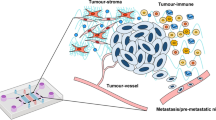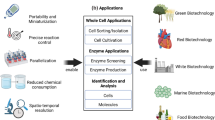Abstract
The trapping or immobilization of individual cells at specific locations in microfluidic platforms is essential for single cell studies, especially those requiring cell stimulation and downstream analysis of cellular content. Selectivity for individual cell types is required when mixtures of cells are analyzed in heterogeneous and complex matrices, such as the selection of metastatic cells within blood samples. Here, we demonstrate a microfluidic device based on direct current (DC) insulator-based dielectrophoresis (iDEP) for selective trapping of single MCF-7 breast cancer cells from mixtures with both mammalian peripheral blood mononuclear cells (PBMC) as well MDA-MB-231 as a second breast cancer cell type. The microfluidic device has a teardrop iDEP design optimized for the selective capture of single cells based on their differential DEP behavior under DC conditions. Numerical simulations adapted to experimental device geometries and buffer conditions predicted the trapping condition in which the dielectrophoretic force overcomes electrokinetic forces for MCF-7 cells, whereas PBMCs were not trapped. Experimentally, selective trapping of viable MCF-7 cells in mixtures with PBMCs was demonstrated in good agreement with simulations. A similar approach was also executed to demonstrate the selective trapping of MCF-7 cells in a mixture with MDA-MB-231 cells, indicating the selectivity of the device for weakly invasive and highly invasive breast cancer cells. The DEP studies were complemented with cell viability tests indicating acceptable cell viability over the course of an iDEP trapping experiment.

ᅟ




Similar content being viewed by others
References
Chao TC, Ros A (2008) Microfluidic single-cell analysis of intracellular compounds. J R Soc Interface 5(Suppl 2):S139–S150
Price AK, Culbertson CT (2007) Chemical analysis of single mammalian cells with microfluidics. Anal Chem 79:2614–2621
Longo D, Hasty J (2006) Dynamics of single-cell gene expression. Mol Syst Biol 2:1–10
Sims CE, Allbritton NL (2007) Analysis of single mammalian cells on-chip. Lab Chip 7:423–440
Burger R, Ducree J (2012) Handling and analysis of cells and bioparticles on centrifugal microfluidic platforms. Expert Rev Mol Diagn 12:407–421
Yin H, Marshall D (2012) Microfluidics for single cell analysis. Curr Opin Biotechnol 23:110–119
Lindstrom S, Andersson-Svahn H (2010) Overview of single-cell analyses: microdevices and applications. Lab Chip 10:3363–3372
Racila E, Euhus D, Weiss AJ, Rao C, McConnell J, Terstappen LWMM, Uhr JW (1998) Detection and characterization of carcinoma cells in the blood. Proc Natl Acad Sci U S A 95:4589–4594
Mostert B, Sleijfer S, Foekens JA, Gratama JW (2009) Circulating tumor cells (CTCs): detection methods and their clinical relevance in breast cancer. Cancer Treat Rev 35:463–474
Nilsson J, Evander M, Hammarström B, Laurell T (2009) Review of cell and particle trapping in microfluidic systems. Anal Chim Acta 649:141–157
Gascoyne PRC, Vykoukal J (2002) Particle separation by dielectrophoresis. Electrophoresis 23:1973–1983
Li Y, Dalton C, Crabtree HJ, Nilsson G, Kaler KVIS (2007) Continuous dielectrophoretic cell separation microfluidic device. Lab Chip 7:239–248
Rosenthal A, Taff BM, Voldman J (2006) Quantitative modeling of dielectrophoretic traps. Lab Chip 6:508–515
Gijs MAM (2004) Magnetic bead handling on-chip: new opportunities for analytical applications. Microfluid Nanofluid 1:22–40
Han K, Frazier AB (2006) Paramagnetic capture mode magnetophoretic microseparator for high efficiency blood cell separations. Lab Chip 6:265–273
Kim Y, Hong S, Lee SH, Lee K, Yun S, Kang Y, Paek KK, Ju BK, Kim B (2007) Novel platform for minimizing cell loss on separation process: droplet-based magnetically activated cell separator. Rev Sci Instrum 78:074301
Grier DG (2003) A revolution in optical manipulation. Nature 424:810–816
Choi S, Park J (2007) Continuous hydrophoretic separation and sizing of microparticles using slanted obstacles in a microchannel. Lab Chip 7:890–897
Neild A, Oberti S, Radziwill G, Dual J (2007) Simultaneous positioning of cells into two-dimensional arrays using ultrasound. Biotechnol Bioeng 97:1335–1339
Wiklund M, Gunther C, Lemor R, Jager M, Fuhr G, Hertz HM (2006) Ultrasonic standing wave manipulation technology integrated into a dielectrophoretic chip. Lab Chip 6:1537–1544
Kwon KW, Choi SS, Lee SH, Kim B, Lee SN, Park MC, Kim P, Hwang SY, Suh KY (2007) Label-free, microfluidic separation and enrichment of human breast cancer cells by adhesion difference. Lab Chip 7:1461–1468
Pethig R (2010) Review article-dielectrophoresis: status of the theory, technology, and applications. Biomicrofluidics 4:022811
Pratt ED, Huang C, Hawkins BG, Kirby BJ, Gleghorn PJ (2011) Rare cell capture in microfluidic devices. Chem Eng Sci 66:1508–1522
Becker FF, Wang XB, Huang Y, Pethig R, Vykoukal J, Gascoyne PR (1995) Separation of human breast cancer cells from blood by differential dielectric affinity. Proc Natl Acad Sci U S A 92:860–864
Wang X, Huang Y, Burt J, Markx G, Pethig R (1993) Selective dielectrophoretic confinement of bioparticles in potential energy wells. J Phys D 26:1278
Park J, Kim B, Choi SK, Hong S, Lee SH, Lee K (2005) An efficient cell separation system using 3D-asymmetric microelectrodes. Lab Chip 5:1264–1270
Wang X, Yang J, Huang Y, Vykoukal J, Becker FF, Gascoyne PRC (2000) Cell Separation by dielectrophoretic field-flow-fractionation. Anal Chem 72:832–839
Shafiee H, Sano MB, Henslee EA, Caldwell JL, Davalos RV (2010) Selective isolation of live/dead cells using contactless dielectrophoresis (cDEP). Lab Chip 10:438–445
Sano MB, Henslee EA, Schmelz E, Davalos RV (2011) Contactless dielectrophoretic spectroscopy: examination of the dielectric properties of cells found in blood. Electrophoresis 32:3164–3171
Henslee EA, Sano MB, Rojas AD, Schmelz EM, Davalos RV (2011) Selective concentration of human cancer cells using contactless dielectrophoresis. Electrophoresis 32:2523–2529
Sano MB, Caldwell JL, Davalos RV (2011) Modeling and development of a low frequency contactless dielectrophoresis (cDEP) platform to sort cancer cells from dilute whole blood samples. Biosens Bioelectron 30:13–20
Cummings EB, Singh AK (2003) Dielectrophoresis in microchips containing arrays of insulating posts: theoretical and experimental results. Anal Chem 75:4724–4731
Jen C, Chen T (2009) Selective trapping of live and dead mammalian cells using insulator-based dielectrophoresis within open-top microstructures. Biomed Microdevices 11:597–607
Kang Y, Li D, Kalams S, Eid J (2008) DC-dielectrophoretic separation of biological cells by size. Biomed Microdevices 10:243–249
Lapizco-Encinas B, Simmons BA, Cummings EB, Fintschenko Y (2004) Insulator-based dielectrophoresis for the selective concentration and separation of live bacteria in water. Electrophoresis 25:1695–1704
Moncada-Hernandez H, Baylon-Cardiel JL, Pérez-González VH, Lapizco-Encinas BH (2011) Insulator-based dielectrophoresis of microorganisms: theoretical and experimental results. Electrophoresis 32:25022511
Jones P, Staton S, Hayes M (2011) Blood cell capture in a sawtooth dielectrophoretic microchannel. Anal Bioanal Chem 401:2103–2111
Bhattacharya S, Chao T, Ros A (2011) Insulator-based dielectrophoretic single particle and single cancer cell trapping. Electrophoresis 32:2550–2558
Lacroix M, Leclercq G (2004) Relevance of breast cancer cell lines as models for breast tumours: an update. Breast Cancer Res Treat 83:249–289
Sommers CL, Byers SW, Thompson EW, Torri JA, Gelmann EP (1994) Differentiation state and invasiveness of human breast cancer cell lines. Breast Cancer Res Treat 31:325–335
Gagnon ZR (2011) Cellular dielectrophoresis: applications to the characterization, manipulation, separation and patterning of cells. Electrophoresis 32:2466–2487
Uchida T, Nagayama M, Gohara K (2009) Trehalose solution viscosity at low temperatures measured by dynamic light scattering method: trehalose depresses molecular transportation for ice crystal growth. J Cryst Growth 311:4747–4752
Longinotti M, Corti HR (2008) Viscosity of concentrated sucrose and trehalose aqueous solutions including the supercooled regime. J Phys Chem Ref Data 37:1503
Srivastava S, Gencoglu A, Minerick A (2011) DC insulator dielectrophoretic applications in microdevice technology: a review. Anal Bioanal Chem 399:301–321
Jesus-Perez NM, Lapizco-Encinas BH (2011) Dielectrophoretic monitoring of microorganisms in environmental applications. Electrophoresis 32:2331–2357
Baylon-Cardiel JL, Lapizco-Encinas BH, Reyes-Betanzo C, Chavez-Santoscoy AV, Martinez-Chapa SO (2009) Prediction of trapping zones in an insulator-based dielectrophoretic device. Lab Chip 9:2896–2901
Viefhues M, Manchanda S, Chao T, Anselmetti D, Regtmeier J, Ros A (2011) Physisorbed surface coatings for poly(dimethylsiloxane) and quartz microfluidic devices. Anal Bioanal Chem 401:2113–2122
Hu Q, Joshi RP, Beskok A (2009) Model study of electroporation effects on the dielectrophoretic response of spheroidal cells. J Appl Phys 106:024701
Bordi F, Cametti C, Rosi A, Calcabrini A (1993) Frequency domain electrical conductivity measurements of the passive electrical properties of human lymphocytes. Nucleus 1153:77–88
Thompson EW, Paik S, Brünner N, Sommers CL, Zugmaier G, Clarke R, Shima TB, Torri J, Donahue S, Lippman ME (1992) Association of increased basement membrane invasiveness with absence of estrogen receptor and expression of vimentin in human breast cancer cell lines. J Cell Physiol 150:534–544
Zeisberg MM, Neilson EG (2009) Biomarkers for epithelial–mesenchymal transitions. J Clin Investig 119:1429–1437
Lee MH, Wu PH, Staunton JR, Ros R, Longmore GD, Wirtz D (2012) Mismatch in mechanical and adhesive properties induces pulsating cancer cell migration in epithelial monolayer. Biophys J 102:2731–2741
Iyer S, Gaikwad RM, Subba-Rao V, Woodworth CD, Sokolov I (2009) Atomic force microscopy detects differences in the surface brush of normal and cancerous cells. Nat Nanotechnol 4:389–393
Yang M, Chao TC, Nelson R, Ros A (2012) Direct detection of peptides and proteins on a microfluidic platform with MALDI mass spectrometry. Anal Bioanal Chem 404:1681–1689
Chuang CH, Huang YW, Wu YT (2011) System-level biochip for impedance sensing and programmable manipulation of bladder cancer cells. Sensors 11:11021–11035
Timonen T, Ortaldo JR, Herberman RB (1981) Characteristics of human large granular lymphocytes and relationship to natural killer and K cells. J Exp Med 153:569–582
Acknowledgments
We thank Prof. Owen McCarty, Oregon Health & Science University, for providing the tomato red transfected MDA-MB-231 cells.
Conflict of interest
The authors declare no conflict of interest.
Author information
Authors and Affiliations
Corresponding author
Electronic supplementary material
Below is the link to the electronic supplementary material.
ESM 1
(PDF 341 kb)
Rights and permissions
About this article
Cite this article
Bhattacharya, S., Chao, TC., Ariyasinghe, N. et al. Selective trapping of single mammalian breast cancer cells by insulator-based dielectrophoresis. Anal Bioanal Chem 406, 1855–1865 (2014). https://doi.org/10.1007/s00216-013-7598-2
Received:
Revised:
Accepted:
Published:
Issue Date:
DOI: https://doi.org/10.1007/s00216-013-7598-2




